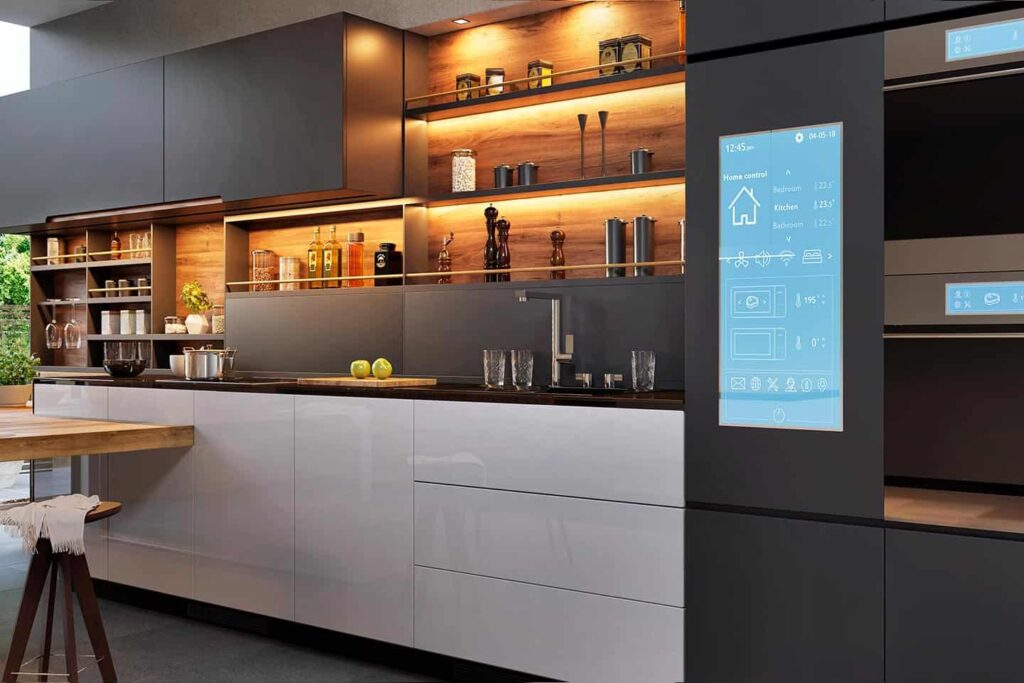The kitchen of tomorrow brings revolutionary changes to how we cook, interact, and live in our homes. Advanced technology, sustainable materials, and thoughtful design converge to create spaces that anticipate needs, save resources, and adapt to changing lifestyles. These innovations go beyond simple upgrades, they fundamentally reshape the heart of the home.
Lancaster Kitchen and Baths stays ahead of emerging trends in kitchen remodeling, bringing tomorrow’s innovations to homeowners today. Our expertise in smart kitchen design and cutting-edge materials helps create spaces that remain functional and beautiful for decades. From voice-activated appliances to sustainable surfaces, we integrate the latest advancements into practical kitchen solutions that enhance daily life.
Smart Appliances Redefining Kitchen Functionality
Intelligent refrigerators now serve as command centers for modern kitchens. These appliances track inventory, suggest recipes based on available ingredients, and automatically order groceries when supplies run low. Built-in cameras allow homeowners to check contents remotely, eliminating forgotten shopping list items and reducing food waste.
Connected ovens and ranges bring precision cooking to every meal. Wi-Fi-enabled models accept voice commands, preheat remotely, and adjust temperatures automatically based on recipe requirements. Some models feature internal cameras and artificial intelligence that recognize dishes and suggest optimal cooking settings, making gourmet results achievable for home cooks.
Dishwashers evolve beyond basic cleaning functions. Tomorrow’s models detect soil levels, adjust water usage accordingly, and send notifications when cycles complete. Advanced filtration systems require less pre-rinsing, saving water and time. Some units even feature UV sanitization for baby bottles and cutting boards, addressing growing health consciousness.
Voice Control and AI Integration
Voice assistants become invisible sous chefs in tomorrow’s kitchens. Homeowners ask for recipe conversions, set multiple timers, or adjust lighting without touching any controls. This hands-free operation proves invaluable when handling raw ingredients or managing multiple cooking tasks simultaneously.
Artificial intelligence learns cooking patterns and preferences over time. Smart systems suggest meal plans based on dietary restrictions, past choices, and available ingredients. They coordinate multiple appliances to have everything ready simultaneously, from preheating ovens to starting coffee makers at optimal times.
Integration extends beyond individual devices. Whole-home systems connect kitchens with other living spaces, adjusting lighting for dining, playing appropriate music, and even notifying family members when meals are ready. This seamless connectivity transforms cooking from isolated tasks into integrated experiences.
Sustainable Materials and Eco-Friendly Innovations
Tomorrow’s kitchens prioritize environmental responsibility without sacrificing style or functionality. Recycled glass countertops offer unique aesthetics while diverting waste from landfills. These surfaces resist stains and scratches while providing distinctive patterns that make each installation unique.
Bamboo and reclaimed wood bring warmth to modern kitchens while supporting sustainable forestry. These rapidly renewable materials work for everything from flooring to cabinet faces, offering durability comparable to traditional hardwoods. Low-VOC finishes protect indoor air quality while maintaining beautiful appearances.
Energy-efficient LED lighting systems reduce power consumption dramatically. Smart controls adjust brightness based on natural light levels and usage patterns. Under-cabinet lighting activates automatically when someone approaches, providing task lighting only when needed. These systems cut energy costs while creating ambiance and improving functionality.
Space-Saving Solutions and Modular Design
Transformable furniture addresses the needs of increasingly diverse living situations. Kitchen islands with adjustable heights accommodate cooking prep, casual dining, and homework sessions. Retractable elements hide when not needed, maximizing open floor plans while maintaining functionality when required.
Modular storage systems adapt to changing needs without renovation. Magnetic wall systems hold knives, spices, and frequently used tools within easy reach. Drawer dividers reconfigure for different utensils or gadgets. Pull-out pantries maximize vertical space while keeping everything visible and accessible.
Appliance garages and hidden charging stations maintain clean aesthetics while providing necessary functionality. Small appliances disappear behind matching cabinet faces when not in use. Built-in USB outlets and wireless charging pads keep devices powered without cluttering countertops with cords.
Health-Focused Features and Wellness Technology
Air quality management becomes standard in tomorrow’s kitchens. Advanced ventilation systems remove cooking odors, excess moisture, and airborne particles more effectively than traditional range hoods. Some systems monitor air quality continuously, adjusting fan speeds automatically to maintain optimal conditions.
Water filtration advances beyond basic carbon filters. Multi-stage systems remove contaminants while preserving beneficial minerals. Some models add electrolytes or adjust pH levels based on user preferences. Built-in sensors alert homeowners when filter changes are needed, maintaining water quality consistently.
Antimicrobial surfaces reduce cross-contamination risks naturally. Copper-infused materials and specialized coatings inhibit bacterial growth on high-touch surfaces. These innovations prove particularly valuable for families with young children or elderly members who may be more susceptible to foodborne illnesses.
Virtual Reality Kitchen Planning
Virtual reality technology revolutionizes kitchen design processes. Homeowners walk through proposed designs before construction begins, experiencing spatial relationships and testing workflow patterns. This immersive planning prevents costly changes during construction and ensures satisfaction with final results.
Augmented reality apps allow visualization of new appliances, finishes, and layouts in existing spaces. Homeowners can see how different cabinet colors look in their actual lighting conditions or test various backsplash options without purchasing samples. This technology streamlines decision-making and reduces design regret.
3D modeling software creates precise construction documents from virtual designs. Contractors receive detailed specifications that minimize errors and miscommunication. Integration with supplier databases ensures accurate pricing and availability information throughout the planning process.
Multi-Functional Kitchen Spaces
Tomorrow’s kitchens serve multiple purposes beyond food preparation. Dedicated beverage stations with built-in coffee systems, wine refrigerators, and filtered water dispensers create specialized zones for different activities. These areas operate independently, allowing multiple people to use the kitchen simultaneously without conflict.
Home office integration acknowledges remote work realities. Built-in desks with concealed keyboards and monitor lifts transform breakfast nooks into temporary workspaces. Charging drawers keep devices powered while maintaining clean surfaces. Sound-absorbing materials reduce noise transmission during video calls.
Entertainment capabilities expand with integrated displays and premium audio systems. Waterproof televisions mounted under cabinets or built into backsplashes provide cooking shows or news updates. Wireless speakers throughout the space create ambiance for dinner parties without visible equipment.
Advanced Storage and Organization Systems
Automated storage solutions bring items to users rather than requiring reaching or climbing. Motorized upper cabinets descend to counter height for easy access. Corner cabinets feature rotating systems that bring contents forward with the touch of a button. These innovations make kitchens more accessible for all users regardless of height or mobility.
Climate-controlled storage preserves different ingredients optimally. Dedicated zones maintain specific temperatures and humidity levels for items like chocolate, wine, or specialty flours. Smart monitoring alerts users when conditions drift outside optimal ranges, protecting valuable ingredients.
Making smaller kitchens function like larger spaces becomes achievable through innovative storage. Ceiling-mounted systems utilize overhead space without overwhelming the room. Toe-kick drawers provide hidden storage for rarely used items. Every square inch serves a purpose without creating visual clutter.
Personalization Through Technology
Biometric systems customize kitchen experiences for individual users. Fingerprint or facial recognition adjusts counter heights, lighting preferences, and even suggests personalized recipes. Family members enjoy tailored experiences without manual adjustments.
Learning algorithms track usage patterns to optimize kitchen operations. Frequently used items migrate to more accessible locations automatically. Lighting scenes adjust based on time of day and typical activities. Coffee makers learn wake-up times and have fresh brew ready without programming.
Customizable interfaces allow users to control their kitchens their way. Some prefer voice commands, others use smartphone apps, and traditionalists stick with physical controls. Tomorrow’s kitchens accommodate all preferences without forcing adoption of unfamiliar technologies.
Future-Proofing Your Kitchen Investment
Planning for tomorrow’s innovations requires flexible infrastructure. Extra electrical circuits, robust Wi-Fi coverage, and accessible wire chases allow easy adoption of new technologies. Neutral base designs accept changing trends through simple updates rather than complete renovations.
Timeless design principles remain important despite technological advances. Quality materials, efficient layouts, and proportional balance create kitchens that age gracefully. Technology enhances these fundamentals rather than replacing them, creating spaces that feel current years after installation.
Professional kitchen designers balance current needs with future possibilities. They specify infrastructure that supports emerging technologies while creating immediately functional spaces. This forward-thinking approach maximizes renovation investments and minimizes future disruption.
Government Resources and Industry Standards
The U.S. Department of Energy provides valuable guidance on energy-efficient kitchen appliances and designs through their ENERGY STAR program. These standards help homeowners select products that reduce environmental impact while lowering utility costs. Following these guidelines creates kitchens that meet both current and future efficiency requirements.
The National Kitchen and Bath Association (NKBA) establishes professional standards and best practices for kitchen design and remodeling. These guidelines address everything from workspace measurements to safety requirements, ensuring kitchens function effectively for all users. Professional designers following these standards create spaces that stand the test of time.
Transform Your Kitchen Into Tomorrow’s Smart Space
The kitchen of tomorrow offers exciting possibilities for homeowners ready to embrace innovation. Lancaster Kitchen and Baths brings expertise in implementing these advanced features while maintaining the warmth and functionality that make kitchens the heart of homes.
Our design team understands how to balance cutting-edge technology with practical daily needs. We create kitchens that impress today and adapt to tomorrow’s innovations, protecting your investment while enhancing your lifestyle.
Ready to bring tomorrow’s kitchen into your home today? Contact our design experts to explore how smart technology and innovative design can transform your cooking and living experience.
Frequently Asked Questions About Tomorrow’s Kitchen Technology
What smart kitchen technologies provide the best return on investment?
Energy-efficient appliances with ENERGY STAR certification typically offer the fastest payback through reduced utility costs. Smart refrigerators that reduce food waste and induction cooktops that use 40% less energy than gas deliver immediate savings. Voice-controlled lighting and automated ventilation systems add convenience while reducing energy consumption. Most homeowners recover smart appliance investments within 3-5 years through operational savings alone.
How do I plan a kitchen remodel that won’t become outdated quickly?
Focus on flexible infrastructure that supports future technology adoption rather than specific devices. Install extra electrical circuits, robust networking capabilities, and accessible pathways for future wiring. Choose neutral finishes and classic layouts that accept updates through accessories and appliances. Work with designers who understand both current trends and emerging technologies to create adaptable spaces.
Can smart kitchen technology work in older homes?
Modern wireless technologies make smart features accessible in virtually any home. Hub-based systems communicate with devices without extensive rewiring. Plug-in modules add intelligence to existing appliances. Professional installers can add necessary infrastructure like neutral wires or dedicated circuits with minimal disruption. Many smart features actually work better in older homes by compensating for outdated systems.
What’s the typical cost difference between traditional and smart kitchen remodeling?
Smart kitchen features typically add 10-20% to traditional remodeling costs, depending on the technology level selected. Basic smart appliances may only add $2,000-5,000 to a project, while fully integrated systems can add $10,000-20,000. Many homeowners phase in smart features over time, starting with key appliances and adding capabilities as budgets allow.
How do I maintain privacy and security with connected kitchen devices?
Choose devices from reputable manufacturers that provide regular security updates. Use strong, unique passwords for each device and enable two-factor authentication where available. Create separate network segments for smart home devices. Review privacy policies before purchasing and disable features that share unnecessary data. Regular firmware updates and basic security practices protect against most risks.





